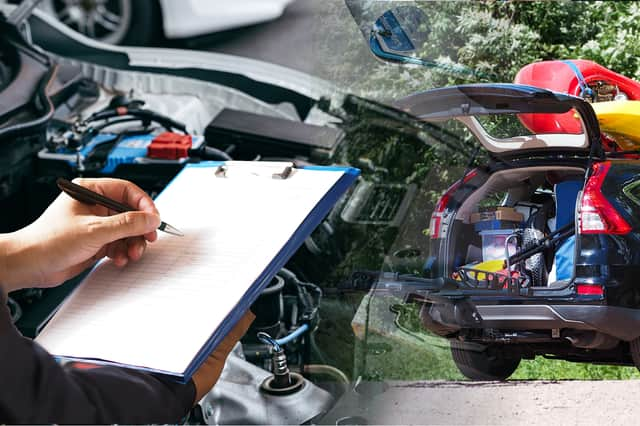Motoring editor Matt Allan does his six car checks before the road trip to avoid a bank holiday disaster.
Drivers are being urged to do basic car maintenance to stay safe and avoid a ruined holiday.
As the cost of living crisis continues to hit motorists, there are fears that drivers looking to save money may be cutting costs when it comes to maintenance. Not only does this put your car at greater risk of untimely breakdown, but road safety groups also warn that it poses a real danger to passengers and other road users.
A new study by safety charity Brake found that 62% of drivers were worried they wouldn’t be able to pay for timely repairs to their vehicle and one in 10 had driven with a warning light on. Breakdown services also warn that cost-cutting drivers could see them avoid essential maintenance.
RAC breakdown spokesman Rod Dennis said: “With so many households under the cosh financially, we are concerned that a lack of essential maintenance could lead to more avoidable breakdowns than we might normally see. Whether a car has been serviced as of late, a quick look at the oil and coolant levels, along with checking that the tires are in good condition and properly inflated, can go a long way in avoiding an unwanted stop on the side of the road.”
Research last year by repair service Bumper found that 71% of drivers did no safety checks or maintenance before setting off on a long journey and only 24% checked basics such as tire pressure tires and screen wash levels. The study also found that two-thirds of drivers relied on scheduled service to identify any problems and a fifth said they did not know how to carry out basic checks.
With this and the RAC’s warning in mind, here are some simple checks you can do at home, which shouldn’t take more than half an hour and could mean the difference between getting to your destination and being stuck on the road .


tires
Having the correct tire pressure is vital to safety and fuel efficiency. If a tire’s pressure drops significantly, it could cause the tire to blow, with the risk of loss of control or an accident. Even before a blowout, low tire pressure will shorten the life of a tire by putting extra stress on it and can reduce vehicle performance and fuel economy. Check your owner’s manual for correct pressure and make sure all tires match. Remember that the correct pressures will vary depending on the load level of the car. Your manual should include different settings depending on whether or not the car is full of passengers and luggage. You should also check your tread depth to make sure it’s within safe legal limits and look for any breaks, cracks or bulges that could lead to tire failure. The legal minimum tread depth limit is 1.6mm, which can be checked with a dedicated tread depth gauge or place a 20p coin in the tire grooves; if the outer band of the coin is hidden, the tires are over the legal limit.
engine oil
If an engine runs out of oil, it can cause serious damage and, in extreme circumstances, cause the engine to shut down completely. If this happened while you were driving, there is a possibility of a serious accident. In less extreme cases, it could still leave you with a massive repair bill. Check the oil levels using the engine dipstick. Make sure the engine is cold and wipe the dipstick with a cloth or tissue before starting. Put the dipstick back in the tube, then remove it and check that the oil is between the min and max marks. Some modern cars have an electronic sensor instead of a dipstick; see your manual on how to use it.
Engine coolant
If coolant is not supplied to the vehicle, the engine overheats, which can lead to costly damage. This is a particular risk in warmer weather and where you might be stuck in stationary traffic for long periods. To check your coolant level, simply find your vehicle’s engine compartment (there will be a diagram in your manual) and see if the coolant is below the minimum marker. Engine coolant can be purchased from any auto parts supplier premixed with water and antifreeze or concentrated, which means it must be diluted.
Headlights, brake lights and indicators
Before embarking on a long journey, it is essential to check that all the vehicle’s lights and indicators are working properly. If drivers drive off with a dim or completely broken light, it could not only increase the risk of an accident, but could also lead to an expensive fine from the police. Be sure to visually check that all lights and indicators are working and replace any bulbs that are dim or completely blown.
Screen wash
Many drivers won’t notice their screenwash container is empty until they need it. If this happens on the road, it could be dangerous as it will be difficult to see out of the windscreen if it is dirty. This can be easily checked by looking at the motor container, which has a min and max marker. Like coolant, you can buy premixed or undiluted screenwash at any motor accessory retailer and many large supermarkets.
battery
A large number of breakdown calls are for dead batteries, so before you start, make sure your car battery is in good condition. There are very few visual clues to the health of a battery, but if the car has difficulty starting or the lights on the dashboard fade when driving, it could be a sign that the battery is dying. When in doubt, have it checked and replaced by a professional before a long trip – you don’t want to stop halfway and find yourself unable to start again.


